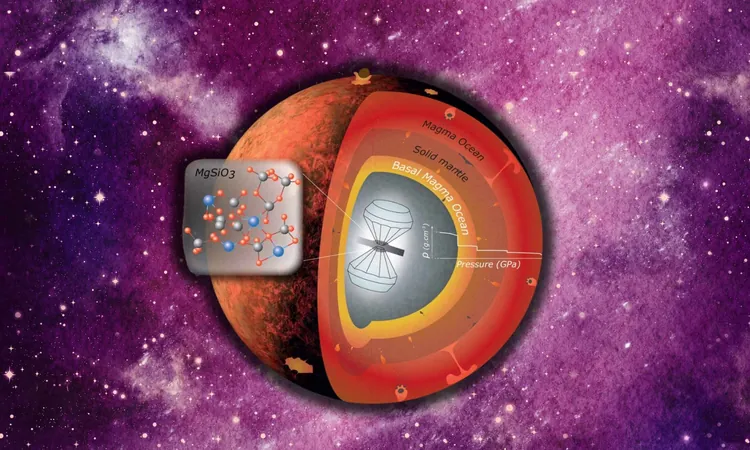
Shocking Discovery: How an 'Ocean of Fire' Shaped Early Earth's Core!
2025-07-16
Author: Daniel
The Fiery Secrets Beneath Our Feet
Did you know that Earth wasn’t always the solid rock we tread upon? Recent groundbreaking simulations suggest that a hidden magma ocean, existing high above the planet's core during its chaotic infancy, played a pivotal role in shaping our world today.
Led by planetary physicist Charles-Édouard Boukaré from York University, researchers argued that this ancient molten layer, known as the basal magma ocean, was a direct outcome of Earth’s early cooling processes. "It's as if the planet holds a memory of its fiery beginnings," Boukaré commented.
Modeling the Birth of Our Planet
In an astonishing study, scientists merged ancient rock isotope data with contemporary seismic images to create a three-dimensional model of the early Earth. Their findings revealed how iron-rich liquids segregated from lighter crystals and navigated downwards to form what could be a massive reservoir beneath the surface.
Rather than supporting prior theories that suggested the mantle froze from the core upward, the new simulations indicate that a thick layer of melt—potentially up to 60 miles (96 kilometers) thick—lingers today, which aligns with seismic data hints suggesting pockets of extraordinary heat above the core.
Unveiling Earth's Deepest Mysteries
As cooling crust at the surface forged early minerals, the weight of these materials caused them to sink back into the mantle. Surprisingly, many of these solidified crystals melted again during their descent. However, some preserved ancient chemical signatures, buried nearly 1,800 miles (2,900 kilometers) deep.
Unique thermal dynamics kept the iron-rich mixture liquid long after the surrounding rock had solidified, locking in a reservoir of rare elements like neodymium and tungsten. This explains the fascinating isotopic fingerprints sometimes seen in modern lava.
Mantle Blobs: Echoes of a Primeval Ocean?
Seismic studies have unveiled massive zones beneath Africa and the Pacific—areas where earthquake waves seem to slow significantly. These regions, known as large low-shear velocity provinces, might actually be remnants of that primordial ocean, over 4.4 billion years old.
While some theories suggest these blobs are merely sunken ocean crust being recycled, the evidence points more convincingly to the basal magma ocean hypothesis, potentially anchoring mantle hot spots responsible for the enduring volcanic trails we now observe.
How Earth's Core Drives Our Planet's Dynamics
The heat escaping from Earth's core not only drives convection but also powers the geodynamo—the engine behind our planet's magnetic field. With a thick layer of molten rock acting as an insulator, it modifies heat flow and could influence magnetic strength across millions of years.
Boukaré speculates that continental drift might also reflect the currents of this deep magma ocean. Changes in melt depth could affect how tectonic plates behave, including their movement and speed, sometimes allowing them to glide along with little friction.
Ancient Rocks Tell New Tales
Isotopic analysis of ancient rocks over 3 billion years old shows subtle variations consistent with interactions between shallow and deep melts, confirming that the history of early Earth is indeed recorded in its geological fabric.
The research reconciles the fact that while upper mantle rocks appear chemically uniform today, this may not always have been the case, opening doors to fresh insights about Earth's formative years.
What Lies Ahead for Planetary Science?
Future experiments aim to squeeze minerals to core pressures, providing further insight into the density and mobility of molten mixtures. Additionally, seismologists are on the lookout for ultrasonic echoes that could confirm the existence of this ancient ocean of fire.
The next decade could revolutionize our understanding of not just Earth, but also other rocky planets, as scientists continue to explore if remnants of the basal magma ocean remain or if it mixed completely over time.
This exciting research has been published in the prestigious journal Nature, redefining our knowledge of Earth’s core and its dynamic history.



 Brasil (PT)
Brasil (PT)
 Canada (EN)
Canada (EN)
 Chile (ES)
Chile (ES)
 Česko (CS)
Česko (CS)
 대한민국 (KO)
대한민국 (KO)
 España (ES)
España (ES)
 France (FR)
France (FR)
 Hong Kong (EN)
Hong Kong (EN)
 Italia (IT)
Italia (IT)
 日本 (JA)
日本 (JA)
 Magyarország (HU)
Magyarország (HU)
 Norge (NO)
Norge (NO)
 Polska (PL)
Polska (PL)
 Schweiz (DE)
Schweiz (DE)
 Singapore (EN)
Singapore (EN)
 Sverige (SV)
Sverige (SV)
 Suomi (FI)
Suomi (FI)
 Türkiye (TR)
Türkiye (TR)
 الإمارات العربية المتحدة (AR)
الإمارات العربية المتحدة (AR)